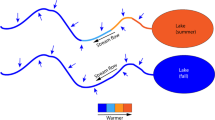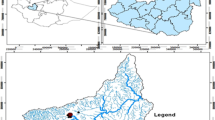Summary
-
1.
Recording thermographs were used to record the water temperatures in three small stony streams in northwest England. These were two Lake District streams, Black Brows Beck and King's Well Beck which rise at altitudes of 246 and 328 m.a.s.l. respectively, and Rough Sike a Pennine stream rising at 686 m.a.s.l.
-
2.
The annual mean water temperatures in Black Brows and King's Well becks were within the range 8 to 10°C but the annual mean in Rough Sike was only 6°C. Rough Sike had lower monthly means than the other two becks during winter and it had a midsummer temperature peak of 11 to 12°C which lasted about one month, whilst the other becks had summer temperature means of 13 to 15°C for three to four months.
-
3.
Rough Sike had an annual temperature sum of about 1700 degree-days above 0°C whilst a value of over 3,000 degree-days was obtained in the other two becks.
-
4.
The daily water temperature range was similar in all three becks. The monthly means of daily ranges were 1.5°C or less during winter and 5 to 7°C during summer, though on some days ranges of 10 to 12°C occurred.
-
5.
Macan (1958) found that in the stream he studied the highest summer water temperatures occurred on days when the sun shone after rain, rather than on sunny rainless days. This conclusion does not appear to be applicable to the becks studied in the present work.
-
6.
Evidence is presented to show that water temperature can be appreciably modified by passage through underground sections of stream.
-
7.
Some general problems of stream temperature measurement were discussed and some tentative calculations were made to illustrate the possible effects of stream temperature on trout metabolism and on the time taken for trout eggs to develop.
Zusammenfassung
-
1.
In drei kleinen steinigen Bächen Nordwestenglands wurden mit Hilfe von Thermographen Wassertemperaturgänge gemessen. Zwei von ehnen, „Black Brows Beck” und „King's Well Beck” entspringen im Lake District in 246 bezw. 328 M Höhe ü.M., während Rough Sike aus 686 M Höhe u. M. in den Pennines kommt.
-
2.
Die jährliche Mitteltemperaturen des „Black Brows” und „King's Well Beck”-Wassers lagen im Bereich von 8 bis 10°C, während im „Rough Sike” die jährliche Mitteltemperatur nur 6°C war. „Rough Sike” hatte im Winter niedrigere monatliche Durchschnitte als die beiden andere Bäche und hatte ein Temperatur-maximum im Sommer von 11 bis 12°C welches ungefähr einen Monat anhielt, während die beiden andere Bäche Hochsommerwerte von 13 bis 15°C zeigten welche drei bis vier Monate anhielten.
-
3.
„Rough Sike” hatte eine jährliche Wärmesumme von 1700 Graden über 0°C während jeder der beiden anderen Bächen einen Wert von 3000 Graden zeigte.
-
4.
Der tägliche Temperaturgang war in allen drei Bächen ähnlich. Das Monatsmittel der Tagesschwankungen gab 1.5°C oder weniger im Winter und 5 bis 7°C im Sommer obgleich in einigen Fällen tägliche Temperaturdifferenzen von 10 bis 12°C vorkamen.
-
5.
Macan (1958) fand in einem Bach die höchsten Sommerwasser-temperaturen an solchen Tagen an denen Sonnenschein auf Regen folgte, nicht, wie zu erwarten wäre, an regenfreien Tagen. Dieser Befund scheint sich nicht auf die hier untersuchten Bäche anwenden zu lassen.
-
6.
Es konnte nachgewiesen werden dass Wassertemperaturen beträchtlich abgeändert werden können, wenn der Bach unterirdische Stecken durchläuft.
-
7.
Einige allgemeine Probleme der Bachtemperaturmessung wurden besprochen und einige Versuchsberechnungen unternommen um zu zeigen, welche Wirkung die Bachtemperatur auf der Stoff wechsel der Forellen and auf die Entwicklungszeit ihrer Eier hat.
Similar content being viewed by others
References
Crisp, D. T. - 1966 - Input and output of materials for an area of Pennine moorland: the importance of precipitation, drainage, peat erosion and animals. J. appl. Ecol. 3: 327–348.
Edington, J. M. - 1966 - Some observations on stream temperature. Oikos, 15: 265–273.
Gray, J. - 1928 - The growth of fish III. The effect of temperature on the development of the eggs of Salmo fario. Br. J. exp. Biol. 6: 125–130.
Harvey, L. A. - 1964 - The ecology of some Dartmoor streams. Dartmoor Essays 173–190.
Macan, T. T. - 1958 - The temperature of a small stony stream. Hydrobiologia 12: 89–106.
Macan, T. T. - 1961 - Factors that limit the range of freshwater animals. Biol. Rev. 36: 151–198.
Millar, A. - 1964 - Notes on the climate near the upper forest limit in the northern Pennines. Q. J. For. 48: 239–246.
Winberg, G. C. - 1960 - Rate of metabolism and food requirements of fishes. Fish. Res. Board Canada Trans. Ser. No. 194. (From: Intensivnost obmena i pischerye petrebrosti ryb. Nauchye Trudy Belorusskovo Gosudarstrenno Universiteta imeni V.I. Lenina, Minsk).
Author information
Authors and Affiliations
Rights and permissions
About this article
Cite this article
Crisp, D.T., Le Cren, E.D. The temperature of three different small streams in northwest England. Hydrobiologia 35, 305–323 (1970). https://doi.org/10.1007/BF00181734
Issue Date:
DOI: https://doi.org/10.1007/BF00181734




